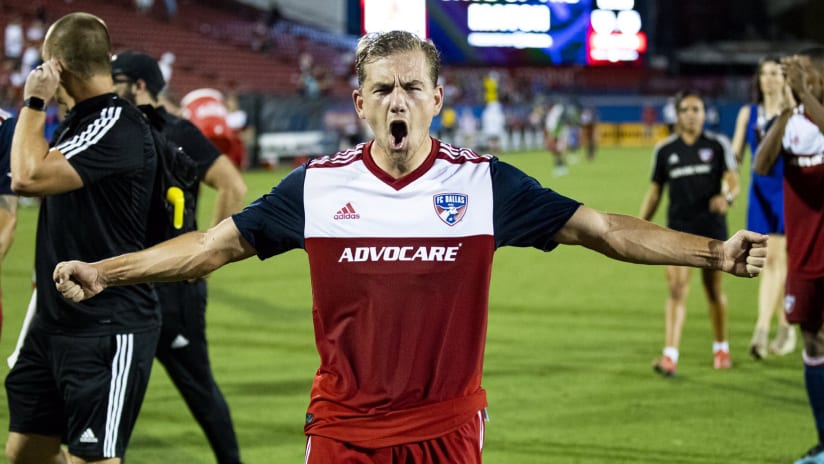NOTE: Every day this week, FC Cincinnati will take a deeper look at various academy programs across MLS that stand out for either their success in developing players for the first team – and international transfers – or for their methodology in training and/or integration into the first team. Last week, we started with an overview. The first three teams featured were Sporting Kansas City, the Philadelphia Union and Real Salt Lake.
Chris Hayden’s office inside Toyota Stadium seems modest. Other than his desk, the only other pieces of furniture are the white table and some chairs.
But then you look around and see the window sills are filled with gold trophies and medals. And when you look at the table again, you remember this is ground zero for American soccer’s youth revolution.
From there, walk through a few doors down a stairwell and alongside the field and you’ll arrive at the National Soccer Hall of Fame. Inside are iconic pieces of this sport’s past and present.
As for its future, it begins in Hayden’s office and the 17 practice fields north of the stadium and hall of fame.
This is where the FC Dallas Academy went from a few business plans to the top academy in the country for pumping out high-quality players.
Twelve years ago, Hayden launched the academy with the hopes of eventually signing a Homegrown Player. They’ve produced 26 since, are the beacon for youth development in MLS and are truly developing players for the global stage.
How?
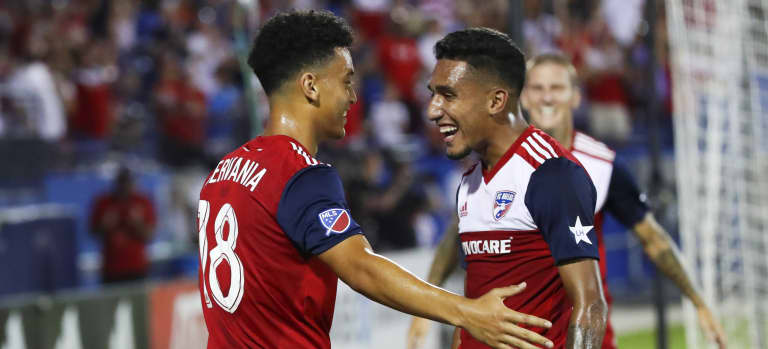
Brandon Servania and Jesus Ferreira. Photo taken by Kevin Jairaj-USA Today Sports.
From a business plan to Homegrowns
“It’s like a swan on top of the water with the feet paddling underneath and no one sees it,” Hayden said of the academy’s work. “We’ve been working for a long time with a similar vision, so I think we have been able to give ourselves a chance to get better. In that evolution, we haven’t really changed course. We just kept working in the same direction and adding resources.
“Year over year, we’ve made small improvements,” he added. “When you look back over time, over 12 years now with the academy, I think we’ve made huge, huge strides. We’re not the same club we were then and I’m not in the same role I was in then.”
The first strides were simply creating a business plan that would make the FC Dallas Academy a success.
Two years before they launched in 2008, Hayden began working on the plans. The year prior, the MLS side bought a local youth club and took over 45 teams. So, by the time the academy launched, FCD already has a base of players, Hayden said.
That wasn’t enough.
While there were talented youth players, there was no pathway to the MLS first team. Before there were any talks of signing professional contracts, FCD needed to streamline a pathway to accelerate development.
But even that was a vision more than reality.
“I remember sitting in meetings with players and maybe there was a top prospect we wanted to bring into our academy but he wasn’t in our club,” Hayden said.
His sales pitch said players would train more frequently and the resources would be available for every player to potentially become a pro.
There was immediate pushback.
Most parents wanted their kids to play college soccer instead. With salaries low in MLS, at least a college soccer player would have a degree before trying to play in the pros. More importantly, though, parents wanted some examples of players that had signed pro contracts from the youth academy into the FC Dallas first team.
No one had – not just in Dallas, but anywhere else in MLS.
“It had never happened before,” Hayden recalled. “We were selling something that in some ways was sort of false. There were no hard examples of (a youth player signing a pro contract).”
“Fast forward 10 years, now when we sit down with a family, if there’s a kid and we say we want to bring you into our academy and we want to sign you to a pro contract, we can start rattling off names,” he said before making a wide grin.
“They know the names.”
An FCD trailblazer at FCC
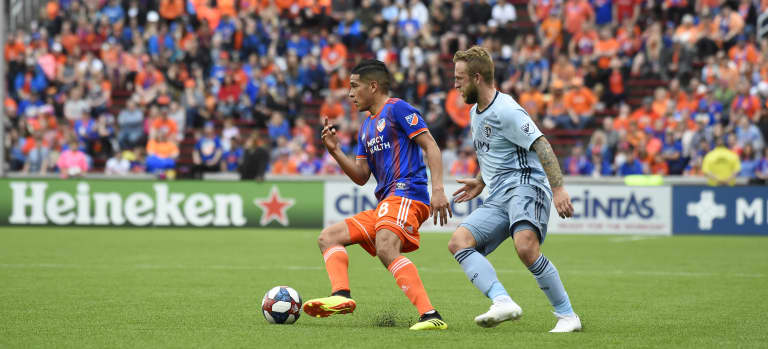
Minutes before the buses pulled away from the Mercy Health Training Center toward the FC Cincinnati Academy’s first exhibition games in Nashville, Frankie Amaya and Victor Ulloa came and spoke to the youth players.
It was an emotional moment. For some players, Amaya was a peer – someone only one or two years older who was already fulfilling his dreams of being a professional player. As for Ulloa’s remarks, they were sentimental and inspiring.
Ulloa was one of FC Dallas’ first academy signings. He was on the inaugural teams and became the club’s second-ever Homegrown Player.
“I know how it feels to be in your shoes,” Ulloa told the FCC youth players. “I signed my first professional contract in 2010 and this is my 10th season as a professional soccer player.”
Whenever Hayden would meet with prospects and their parents, there’s no doubt Ulloa was used as the prime example of what a former academy player can become: a veteran MLS player with a respectable career.
Before joining FC Cincinnati last offseason (he was traded to Inter Miami CF in November), Ulloa spent nine seasons with FC Dallas, amassing 144 regular-season appearances. By the time he left North Texas, he was their longest-tenured player and the longest-tenured Homegrown Player in MLS history.
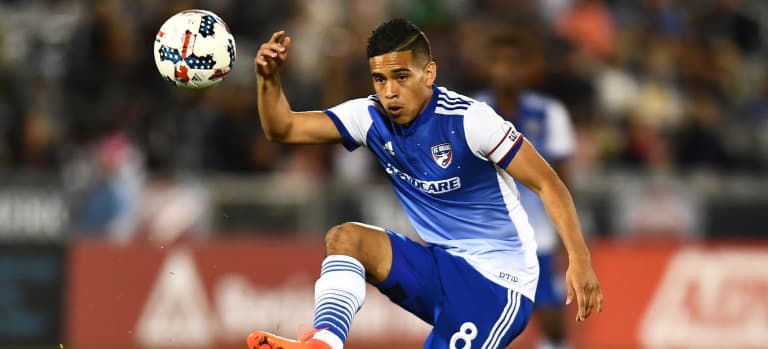
Ulloa from his time in Dallas. Photo taken by Ron Chenoy-USA Today Sports.
From the time Ulloa joined the FCD first team until the time he left, the academy developed so quickly that he eventually needed to leave in order for other Homegrown Players to breakthrough into the first team.
“If Victor was 10 years younger or 15 years younger and playing for us now, we would have so much support for him and would probably get him into the first team much quicker than we did,” Hayden said.
And yet, if the first players like Ulloa never signed, it’s fair to suggest the Dallas youth setup might look drastically different than its current resemblance.
Ulloa helped create the club’s culture and legacy by becoming one of the first academy players. Now, there have been players in that academy who’ve been there since the center midfielder signed his first pro contract.
When Ulloa and FC Cincinnati lost, 3-1, in Toyota Stadium this past August, Dallas used six Homegrown Players against Cincinnati, while two more were available on the bench.
One of those HGs – Jesus Ferreira – started and had the game-winning assist. He joined the FCD Academy the same year Ulloa joined the club’s first team.
How did these youth players develop so quickly?
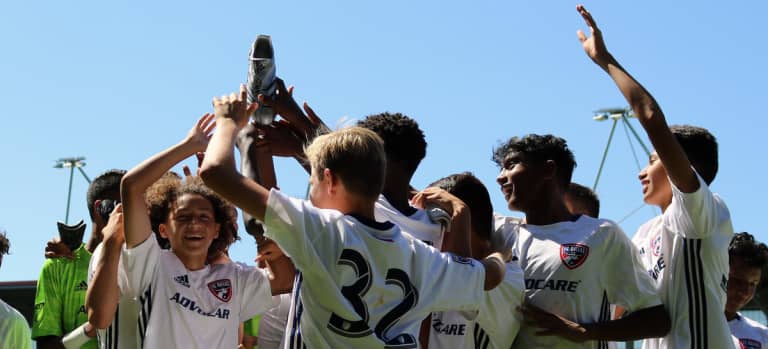
FCD's Under-15 team. Photo provided by FC Dallas.
“Our owners want to play young players, they want to invest in young players and have them represent the team at the first-team level,” Hayden said. “I don’t think anything we’ve done or will do can be done without that because if the first team plan is different from that, then it’s impossible to create that environment.”
But there’s also more than just a commitment from ownership. Several other factors have transformed the club from an academy with lofty hopes into the benchmark across MLS.
Some of those reasons include (in no order)…
1. Consistency.
Because FC Dallas ownership have stuck to their beliefs in developing youth players, that’s allowed more players to come through the academy and enter North Texas SC – the club's USL League One team – or the first team.
There’s an on-record goal that Dallas will play a starting XI comprised exclusively with HGs. Considering the roster currently has 10 of them, that achievement might happen fairly soon.
Had the academy changed its curriculum – or a first team coach or GM done so – the consequences could’ve drastically changed the club’s current trajectory. The patience is paying off.
2. Structure
The consistency has led to solid structure. Remember when Hayden said there was no pathway for players into the first team? The FCD Academy now have an Under-6 team and work up from there.
Overall, there are currently 250 boys and girls teams in the Dallas-Fort Worth Metroplex. Beyond that, the club has 12 affiliates outside the market.
“We cast a really wide net,” Hayden said.
So, if a player is good enough to advance through that competition to sign a professional contract, no wonder that talent is better than what other MLS clubs often produce.
Additionally, FCD created North Texas SC in 2019 as another team in the development pathway. With a roster filled with teenagers, they won the league by 10 points and claimed the postseason championship, too.
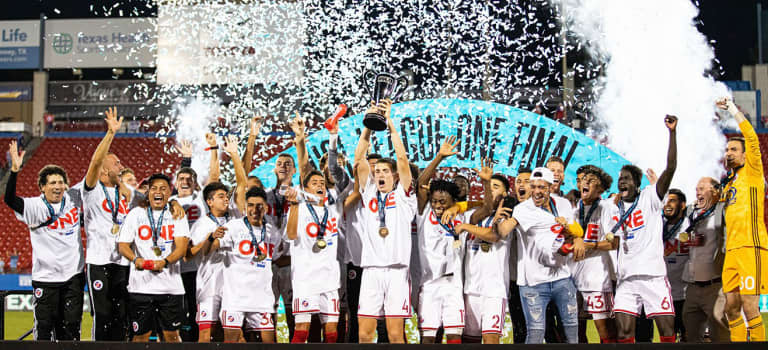
North Texas SC. @northtexasSC, Twitter.
That level of quality is why players like Ulloa needed to move on. He was a good player, but there’s a potential someone 10 years younger than him is in the academy and is waiting for an MLS opportunity.
3. Facility
Having 17 practice fields outside Toyota Stadium won’t hurt matters. There are an additional 15 fields outside of the complex that the academy uses.
4. Flexibility
Remember how the Real Salt Lake Academy have their own high school? Dallas doesn’t have that, but the academy has worked with a local school district to create flexible schedules for students. This plays directly into the fifth reason…
5. Climate
North Texas can get very, very hot. Therefore, kid practicing in the morning makes sense. But by having a warm climate year-round, that allows players to keep playing when other MLS academies have to slow down during the winter. This creates an instant advantage against other clubs across the country, in addition to allowing FC Dallas to host national and international competitions.
The Dallas Cup is an annual tournament that features more than 900 players every spring. Teams from six continents have participated, which means FCD Academy can remain at home while comparing their top prospects against teams from Europe, South America and other continents.
Additionally, the Generation adidas Cup is held annually in Dallas to crown the top academy teams from across the country.
“I think we have sort of a perfect storm of all the necessary ingredients,” Hayden said.
FCD Academy’s influence stretches far beyond Homegrown Player signings
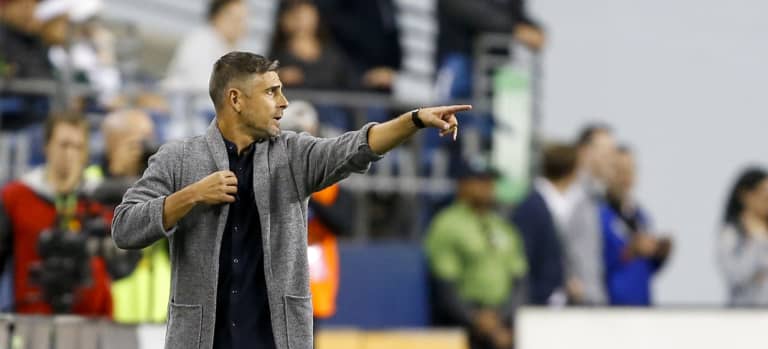
FCD coach Luchi Gonzalez. Photo taken by Joe Nicholson-USA Today Sports.
On Dec. 16, 2018, FC Dallas hired Luchi Gonzalez as to replace Óscar Pareja as coach.
From the outside, the hiring was met with surprise. Gonzalez had never coached a club team professionally and had never even sat on the bench as an assistant coach during a first team game. Therefore, his first stint as a first team head coach would be overseeing a club that perennially makes the postseason.
“Internally, that decision made perfect sense,” Hayden said. “To have an outsider with another philosophy makes no sense for this organization. It really should be someone that’s continuing the work of the academy.”
What was the new hire’s previous job? An academy coach.
As for Pareja, he was also promoted from the academy, and he immediately hired his assistants from the same background.
Just as FCD have built their club around academy products, their coaching hires come from the same place.
“We’ve got coaches that are on our first team staff who haven’t just worked with the academy,” Hayden said. “They know the players first hand. The guys we’re signing today, it’s more than likely that (these coaches) coached them two or three years ago.”
The club that once wanted one Homegrown Player has produced 26 of them, and is producing its future coaching staff, too.
The next frontier
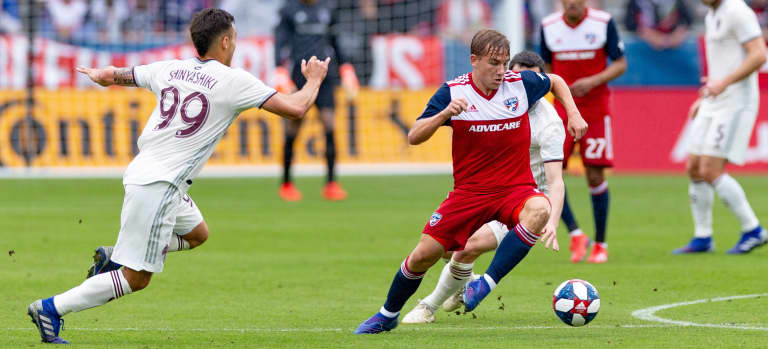
Paxton Pomykal. Photo taken by Andrew Dieb-USA Today Sports.
When MLS named its “22 Under 22” list earlier this month, FC Dallas unsurprisingly led the pack with young talent.
Paxton Pomykal was voted third after claiming only two MLS starts entering 2019 and quickly developed into one of the top young American talents in the league. The midfielder captained the U.S. Under-20 National Team in the World Cup and ended the season playing for the USMNT. (It’s more than likely that the 19-year-old mid received less playing time in 2018 when Ulloa was occupying the same role.)
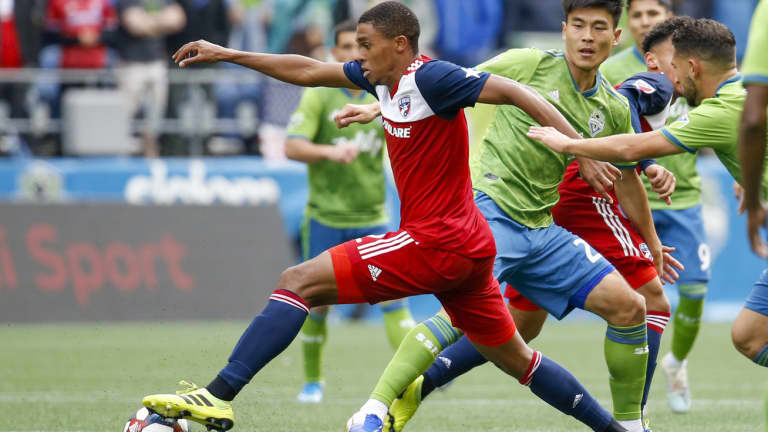
Reggie Cannon. Photo taken by Joe Nicholson-USA Today Sports.
Reggie Cannon might be the country’s new first-choice right back and is gaining interest from an English Premier League side, according to The Athletic. He was ranked fifth in the MLS list.
Ferreira, who had the assist against Cincinnati, is ranked ninth, while midfielder Brandon Servania was No. 18.
Unless someone leaves the club, expect all four to be back in this list next season, in addition to 16-year-old forward Ricardo Pepi.
All of these players represent the other side of FC Dallas: it’s not just about MLS trophies. Making money from international transfer business matters, too.
As MLS transitions toward becoming a selling league, FCD have embraced the role.
“We really feel we’re part of a global community,” Hayden said.
Perhaps that’s why the club hosts youth tournaments in Dallas to scout other teams and see where their prospects are lacking.
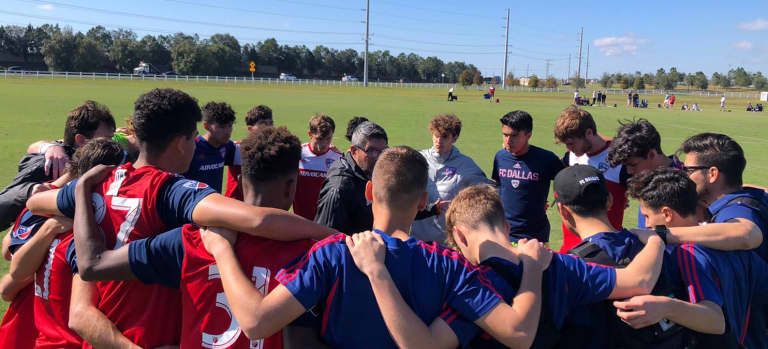
FCD's U-19 team. @FCDallasYouth, Twitter.
The U-9 and U-10 team recently went to Spain. The U-11s went to Brazil. The 15’s spent time this past summer with Bayern Munich in Germany, while the 17’s were in a Mexican tournament.
These tournaments cost money, but they’re enjoyable for the players and worthwhile for the coaches and academy staff.
Theoretically, they’re also a chance for players to visit a country before they eventually start a career there.
For as many players who came through the academy and went on to the FC Dallas first team, the names that have played in the academy are arguably more impressive.
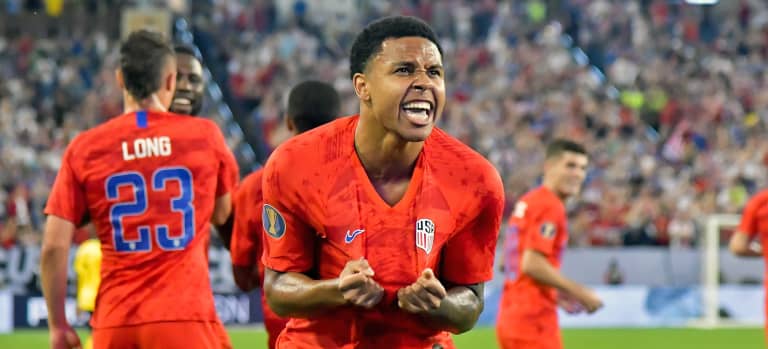
Weston McKennie. Photo taken by Jim Brown-USA Today Sports.
Weston McKennie, a 21-year-old mid who starts for the USMNT, played for the academy before joining Schalke in the Bundesliga. He plays regularly.
Chris Richards was also in the academy before joining Bayern – a club FCD have an official relationship with. The Funes Mori brothers, Rogelio and Ramiro, both represented the academy, too. Rogelio plays for Concacaf Champions League winners Monterrey, while Ramiro is at Villareal in Spain and plays for the Argentina National Team.
As the Pomykal-Ulloa instance highlighted, FC Dallas are actually developing too many good players too quickly. This is a great problem to have, but it clogs pathways for future players to develop and make an impact on the first team.
“It would be really silly for us to think we could sign some of our top talent and they would all be able to continue to develop in our first team,” their academy director said. “We have to be thoughtful about our players and about our roster, and that means we have to sell players.”
Think about some of the most famous selling clubs in the world: SL Benfica (Portugal), AS Monaco (France) or AFC Ajax (the Netherlands).
As soccer continues to develop in this country, FC Dallas want to get in on the action.
“I say this to every player that comes through: I would love for you to play your entire career here,” FCD President Dan Hunt told MLSsoccer.com last month. “But I’m a realist, and the game is not like that … If a player is bumping up against a ceiling and has the opportunity to grow and get better, we’ll be supportive of that as long as it benefits FC Dallas and the player.”
This mentality has developed from Hayden’s meetings with prospects and their parents at his office table. Then, he wanted to sign a first or second Homegrown.
Now, the rest of MLS wants to know how they can catch up.

